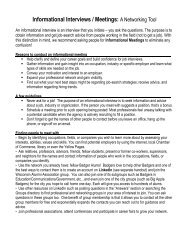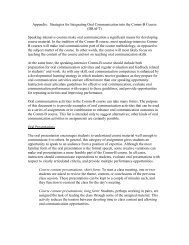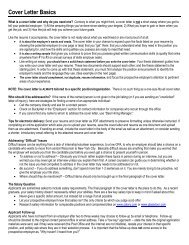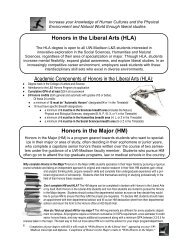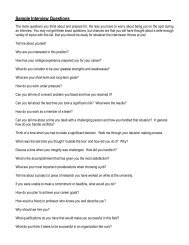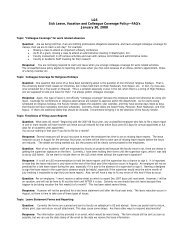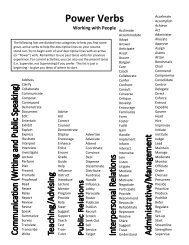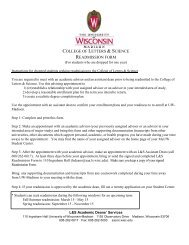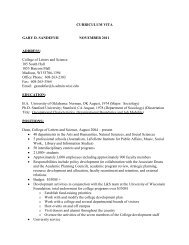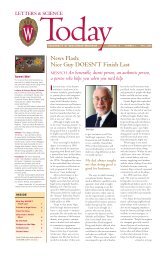The Liberal Arts Advantage - College of Letters & Science News
The Liberal Arts Advantage - College of Letters & Science News
The Liberal Arts Advantage - College of Letters & Science News
You also want an ePaper? Increase the reach of your titles
YUMPU automatically turns print PDFs into web optimized ePapers that Google loves.
<strong>The</strong> <strong>Liberal</strong> <strong>Arts</strong> <strong>Advantage</strong><strong>The</strong> Annual Report <strong>of</strong> the <strong>College</strong> <strong>of</strong> <strong>Letters</strong> & <strong>Science</strong>, 2012–2013
Explore the Wonderful.Last year, gifts to the <strong>Letters</strong>& <strong>Science</strong> Annual Fundprovided funding for classicspr<strong>of</strong>essor and archaeologistWilliam Aylward, workingwith a team <strong>of</strong> UW-Madisonstudents, to launch anunparalleled researchexpedition at the historicsite <strong>of</strong> Troy.To read more about the Troyexpedition, turn to page 12.Your support makesa difference.ISTOCK PHOTOWILLIAM AYLWARD
<strong>The</strong> <strong>Liberal</strong> <strong>Arts</strong> <strong>Advantage</strong>COLLEGE OF LETTERS & SCIENCE ANNUAL REPORT, 2012–2013Editor: Megan CostelloWriters: Mary Ellen Gabriel, Tom ZiemerPhotography: Sarah MortonDesign: Colleen O’Hara,Wisconsin Alumni Association®<strong>College</strong> <strong>of</strong> <strong>Letters</strong> & <strong>Science</strong> AdministrationJohn Karl Scholz, DeanMaria Cancian, Associate Dean for Fiscal Initiatives,Social <strong>Science</strong>sSusan Ellis-Weismer, Associate Dean for ResearchServicesGery Essenmacher, Associate Dean for StudentAcademic AffairsAnne Gunther, Associate Dean for Budget —Finance, Budget Planning and AnalysisNancy Westphal-Johnson, Senior Associate Deanfor Administration and Undergraduate EducationEric Wilcots, Associate Dean for Biological andPhysical <strong>Science</strong>sSusan Zaeske, Associate Dean for Advancement,<strong>Arts</strong> & HumanitiesContact UsMegan Costello, EditorRoom 402 South Hall1055 Bascom MallMadison, WI 53706info@ls.wisc.eduTo Make a GiftAnn DingmanUW Foundation1848 University AvenueMadison, WI 53726(608) 265-9954Ann.Dingman@supportuw.org4 FROM THE DEAN’S DESKJohn Karl Scholz, a member <strong>of</strong> the UW-Madison faculty since1988, became the 12th dean <strong>of</strong> the <strong>College</strong> <strong>of</strong> <strong>Letters</strong> &<strong>Science</strong> in July, after serving as chair <strong>of</strong> the Department <strong>of</strong>Economics.6 THE SANDEFUR LEGACYGary Sandefur, who served as L&S dean for nine years, leaveshis post after increasing faculty retention, boosting financialsupport for students, and helping to raise and steward morethan $240 million in gifts.8 THE HEART OF A GREAT UNIVERSITYL&S faculty make research discoveries that change the world,help preserve culture under threat, and prepare students forthe jobs <strong>of</strong> the future — and none <strong>of</strong> it would be possiblewithout the support <strong>of</strong> our alumni and friends.20 EMERITI VOICESPr<strong>of</strong>essor Emeritus Yi-Fu Tuan, the father <strong>of</strong> humanistgeography, remains at home on the UW-Madison campus15 years after retiring.22 LIBERAL ARTS ACHIEVERSA liberal arts education prepares students for success byexposing them to eye-opening research and giving them theskills to make a good living and lead a good life.26 WORKING LIFEL&S graduates launch innovative startups and carry theWisconsin Idea into their pr<strong>of</strong>essional lives.30 BY THE NUMBERSAnnual production <strong>of</strong> <strong>The</strong> <strong>Liberal</strong> <strong>Arts</strong> <strong>Advantage</strong> issupported by financial gifts from alumni and friends.COVER PHOTO: ANDY MANISfacebook.com/uwmadisonLStwitter.com/uwmadisonLSuwmadisonls.tumblr.cominstagram.com/uwmadisonlsls.wisc.edureport.ls.wisc.edu
FROM THE DEAN’S DESKWelcomingDean John Karl ScholzAs the new dean <strong>of</strong> the University <strong>of</strong> Wisconsin-Madison’s <strong>College</strong> <strong>of</strong> <strong>Letters</strong>& <strong>Science</strong>, I am delighted to introduce myself and share with you some <strong>of</strong> themany reasons I am honored and excited to serve the college.As the heart <strong>of</strong> this great university and the largest school on campus, L&S is vitallyimportant to the mission <strong>of</strong> UW-Madison. <strong>The</strong> college provides between 40 and 60 percent<strong>of</strong> the credits for other schools and colleges, and maintains a fierce commitment to theuniversity’s famous “sifting and winnowing” approach.Our students learn to analyze from multiple perspectives; write, present, and solveproblems; apply evidence-based research in real-world settings; and reflect on the humancondition. As an economist, I have devoted my scholarly career to studying the ways in whichhuman beings respond to the world’s complexity. We are increasingly interconnected throughtechnology and economic growth. I believe our students must graduate as engaged globalcitizens in order to successfully navigate through work and life.L&S <strong>of</strong>fers crucial preparation for that role. Perhaps the most valuable skill a liberal artsgraduate can bring to our knowledge-based economy is the passion to keep learning. <strong>The</strong>college fosters curiosity, creativity, innovation, and a generous spirit. L&S graduates take thoseskills out into the world to become caring community members, valued employees, awardwinningscholars, entrepreneurs, artists, and more.<strong>The</strong> abilities to think critically, grasp complexity, and adapt to change are hallmarks <strong>of</strong>a liberal arts education, and a recent survey by the Association <strong>of</strong> American <strong>College</strong>s andUniversities showed that 93 percent <strong>of</strong> employers value these skills above a specific major.Within the pages <strong>of</strong> <strong>The</strong> <strong>Liberal</strong> <strong>Arts</strong> <strong>Advantage</strong>, you will read about the faculty, staff,students, and alumni who, together, make the college a great place to teach, study, and learn.Breaking the boundaries <strong>of</strong> geography, archaeology, and molecular biology; opening newfrontiers in digital literacy and online learning; using an L&S degree in unique and pr<strong>of</strong>itableways — these are just some <strong>of</strong> the stories that showcase not only what we have done, butwhat we are capable <strong>of</strong> achieving as we seize future challenges with our trademark brand <strong>of</strong>collegiality and intellectual rigor.My predecessor, Gary Sandefur, did a wonderful job in his nine years as dean. I start tryingto fill his formidable shoes with my eyes, ears, mind, and heart open to opportunities thatwill help our students to pursue satisfying careers; to be enthusiastic, lifelong learners; and tomaintain our stellar, international reputation for research and teaching excellence.On, Wisconsin!John Karl ScholzDean and Pr<strong>of</strong>essor <strong>of</strong> Economics4 L&S Annual Report 2012–2013: <strong>The</strong> <strong>Liberal</strong> <strong>Arts</strong> <strong>Advantage</strong>
JEFF MILLER, UNIVERSITY COMMUNICATIONSFarewell to Gary SandefurFrom humble beginnings to dean <strong>of</strong> UW-Madison’s largestcollege, Sandefur held fast to valuesIn July, the <strong>College</strong> <strong>of</strong> <strong>Letters</strong>& <strong>Science</strong> bid farewell to GarySandefur, who presided for nineyears as the dean <strong>of</strong> the University<strong>of</strong> Wisconsin-Madison’s largestacademic unit.Sandefur, known for his ability to listenand appreciate many points <strong>of</strong> view, inspiredstrong loyalty.Approachable and down to earth,Sandefur could talk to anyone. Facultyrespected him. Donors trusted him. Staff andstudents say they felt welcome to drop byand talk anytime. Colleagues in the AmericanIndian Studies Program, where he was directorfor three years, treated him like family.Former UW-Madison Chancellor DavidWard put it best, when recalling the searchfor an associate vice chancellor for academicaffairs — a position Sandefur held from 1992to 1996.“I didn’t want loud, pushy people,” saysWard. “I wanted people who had clear goalsbut who would execute them in a kind <strong>of</strong>quiet, diplomatic style. … That’s exactly what(Gary) did.”Sandefur’s outlook was shaped by hishumble upbringing in rural Madill, Oklahoma.Following a childhood spent galloping6 L&S Annual Report 2012–2013: <strong>The</strong> <strong>Liberal</strong> <strong>Arts</strong> <strong>Advantage</strong>
his horse, Thunder, over the open plains,fishing with his father, and hunting birds,Sandefur attended the University <strong>of</strong>Oklahoma with the help <strong>of</strong> the Johnson-O’Malley Act. <strong>The</strong> act provided financialassistance to Native American collegestudents, including Sandefur, a member <strong>of</strong>the Chickasaw Nation.At age 18, he enrolled at the University<strong>of</strong> Oklahoma and married high schoolsweetheart Kathy Wallace. In November <strong>of</strong>his sophomore year, the couple welcomedtheir first child. Sandefur was working 30hours a week at Arby’s to help support hisfamily. It was overwhelming, and he droppedout — only to return to school a year later,recharged, and on his way toward adistinguished career in higher education,starting with a Ph.D. at Stanford.“If you go through experiences like that,it gives you an appreciation for other people’sproblems,” says Sandefur. “I think it’s made mea better person, a more understanding person.”As dean <strong>of</strong> the <strong>College</strong> <strong>of</strong> <strong>Letters</strong> &<strong>Science</strong>, Sandefur increased faculty retention,boosted financial support for students,tackled diversity issues, and helped to raiseand steward more than $240 million in giftsfrom alumni, friends, and foundations toadvance the school’s liberal arts mission.When Sandefur started as dean in 2004,fundraising was considered a new task forleaders <strong>of</strong> public research universities, whichhad relied for many years on state and federalsupport. His approach to this now crucial rolefor administrators has become a model atUW-Madison.“I have never felt like Gary said aninauthentic word in his life,” says MichaelKnetter, president and CEO <strong>of</strong> the UWFoundation. “Being thanked by him is evenmore important from that standpoint. Hethinks about the deeper meaning <strong>of</strong> things.It’s not just money; it’s what it does for ourstudents.”Sandefur worked closely with the L&SBoard <strong>of</strong> Visitors, an advisory group <strong>of</strong> some<strong>of</strong> the college’s most generous friends andsupporters, to address student financial aid,faculty retention, and research support.With help from the board, Sandefurraised nearly $850,000 for need-basedscholarships and more than $780,000 fordiscretionary use. He implemented the FacultyFellows program to retain top faculty — andall 28 Faculty Fellows are still at UW-Madison.<strong>The</strong> L&S board also raised $200,000 for VilasDistinguished Achievement Pr<strong>of</strong>essorships, acampus-level retention program modeled onthe L&S Faculty Fellows concept.During Sandefur’s tenure, the Andrew W.Mellon Foundation supported post-doctoraland graduate fellowships, faculty chairs,and research, and made a $10 million grant(matched by the state) to build core capacityfor research and teaching in the humanities.“I think many people think thatfundraising is just going out and askingpeople for money,” he says, “but it’s reallybuilding relationships with people over time.”After a year’s leave, Sandefur returnsto teaching in the Department <strong>of</strong> Sociologyin fall 2014, where he built a reputationas a world-renowned demographer whoseresearch addressed pr<strong>of</strong>ound challengesfacing society, including family structure,poverty, and the educational and economichurdles faced by ethnic minority groups.When he eventually retires and returnsto Oklahoma, he says he will remember thejoys <strong>of</strong> watching new faculty hires grow,seeing the throngs <strong>of</strong> energetic studentsreturn to campus each fall, and meeting andbuilding relationships with alumni and donorsall across the country.“It’s been a wonderful experience,”Sandefur says.THE SANDEFUR LEGACYreport.ls.wisc.edu 7
THE HEART OF A GREAT UNIVERSITYA Year <strong>of</strong> Innovation,Discovery, and OutreachPushing the boundaries <strong>of</strong> scientific research. Sharinghistory, literature, and culture with the community. Leadingadvances in teaching through new technologies.In 2012–2013, faculty, students, and alumni <strong>of</strong> the <strong>College</strong> <strong>of</strong> <strong>Letters</strong> &<strong>Science</strong> carried the Wisconsin Idea out into the world, changing the way wethink and learn about our past, present, and future.JEFF MILLER, UNIVERSITY COMMUNICATIONSChanging lives throughShakespeare and Plato<strong>The</strong> Odyssey Project, a program that <strong>of</strong>fersfree humanities classes to low-income adultstudents, celebrated its 10th year <strong>of</strong> bringinghigher learning to those who can least affordit. “Education is what can break the cycle <strong>of</strong>generational poverty,” says Emily Auerbach,pr<strong>of</strong>essor <strong>of</strong> English and the director andfounder <strong>of</strong> the Odyssey project.Discovering the Higgs bosonPr<strong>of</strong>essors Sau Lan Wu (Physics), picturedabove, Wesley Smith (Physics), and MironLivny (Computer <strong>Science</strong>s) contributedto the July 2012 discovery, in Geneva,Switzerland, <strong>of</strong> a new particle that isbelieved to be the elusive Higgs boson —the particle thought to be responsible forimparting mass to matter.Char Braxton (’06) hugs Pr<strong>of</strong>essor EmeritusRobert Auerbach at the Odyssey Project’s 10thanniversary celebration.RICHARD BAKER, MADISON PHOTOGRAPHICS8 L&S Annual Report 2012–2013: <strong>The</strong> <strong>Liberal</strong> <strong>Arts</strong> <strong>Advantage</strong>
SARAH MORTON, COLLEGE OF LETTERS & SCIENCE<strong>The</strong> Freeing <strong>of</strong> the Slaves, a 37-foot-long mural painted by John Steuart Curry, adorns the wall in the Quarles & Bradyreading room in the UW Law Library.Marking a historic moment<strong>The</strong> Emancipation Proclamation transformed the direction <strong>of</strong> the United States. To celebrate the edict’s 150thanniversary, Pr<strong>of</strong>essor <strong>of</strong> History Steve Kantrowitz led a yearlong series <strong>of</strong> free, public talks across campus thatexamined the events leading up to the freeing <strong>of</strong> the slaves and the struggles that followed. Kantrowitz’s most recentbook — More Than Freedom: Fighting for Black Citizenship in a White Republic, 1829–1889 — focuses on blackreformers in the city <strong>of</strong> Boston.Teaching with passionSeven out <strong>of</strong> 10 <strong>of</strong> the 2013 DistinguishedTeaching Awards went to L&S faculty:William Aylward — pr<strong>of</strong>essor <strong>of</strong> classicsSeth Blair — pr<strong>of</strong>essor <strong>of</strong> zoologyStefania Buccini — pr<strong>of</strong>essor <strong>of</strong> Frenchand ItalianRajiv Rao — assistant pr<strong>of</strong>essor <strong>of</strong> Spanishand PortugueseKaryn Riddle — assistant pr<strong>of</strong>essor <strong>of</strong>journalism and mass communicationEdwin Sibert — pr<strong>of</strong>essor <strong>of</strong> chemistryTehshik Yoon — associate pr<strong>of</strong>essor <strong>of</strong>chemistryExpanding the classroomUniversities around the world are embracingonline learning to meet the needs <strong>of</strong> 21stcenturystudents. In February, UW-Madisonannounced that it had partnered with theonline learning company Coursera to pilotfour Massive Open Online Courses (MOOCs).Pr<strong>of</strong>essor <strong>of</strong> Geography Kris Olds andAssociate Pr<strong>of</strong>essor <strong>of</strong> Anthropology JohnHawks will each teach courses, which are freeand open to anyone.Exploring the final frontierPr<strong>of</strong>essor <strong>of</strong> Botany Simon Gilroy is workingwith NASA to discover how plants wouldfare in space. In March, a rocket carryingArabidopsis, or “mouse-eared cress,” blasted<strong>of</strong>f, carrying this “lab rat <strong>of</strong> plant biology” tothe International Space Station. <strong>The</strong> long-termgoal is to integrate plants into space missions,both for food and to purify the air and water.Celebrating our alumniFour out <strong>of</strong> five Distinguished Alumni Awardswent to L&S alumni in 2012: Carl Djerassi(Ph.D.’45, Chemistry), the co-inventor <strong>of</strong>the first successful oral contraceptive andan accomplished playwright and author;Kay Koplovitz (B.S.’67, Radio, Television &Film), television’s first female cable networkpresident; Cora Marrett (M.A.’65, Ph.D.’68,Sociology), the deputy director <strong>of</strong> the National<strong>Science</strong> Foundation; and Ben Sidran (B.S.’67,English), a Grammy-nominated jazz musician.report.ls.wisc.edu 9JEFF MILLER, UNIVERSITY COMMUNICATIONS
PHOTO COURTESY OF BRENT HUFFMANTHE HEART OF A GREAT UNIVERSITYArchaeologists on theFront Lines<strong>The</strong> work to protect ancient cultures from modern threatsJ. Mark Kenoyer stands on awindswept peak in Logar Provincein eastern Afghanistan, his headwrapped against the harsh sun in atraditional scarf.As he chats in a mixture <strong>of</strong> Urdu andPashto with an Afghan archaeologist, it’s easyto see why documentarian Brent Huffmanwanted the UW-Madison pr<strong>of</strong>essor <strong>of</strong>anthropology to appear in his upcoming filmabout Mes Aynak,a 2,600-yearoldBuddhistmonastery.Huffmanneededsomeonewho couldarticulatewhat will belost when anew copperminedestroys this archaeological treasure. Kenoyer,at home in the region and with its languagesand culture, was his man.<strong>The</strong> camera follows Kenoyer’s gazeacross a vast complex <strong>of</strong> stone houses,passageways, burial chambers, and stupas(ceremonial monuments), dotting thedesolate landscape as far as the eye can see.“This whole mountain containsartifacts,” says Kenoyer. “<strong>The</strong>y buriedmanuscripts inside the buildings that couldtell us about life and commerce along theSilk Road. Archaeologists need 30 years toproperly excavate this site.”Unfortunately, all they have is about ninemonths.“<strong>The</strong> question can be put toeveryone on the face <strong>of</strong> the earth:what is worth saving?”— William Aylward<strong>The</strong> China Metallurgical Group has said itwill close the site to archaeologists next yearand begin preparing the area to make way fora massive copper mine. Archaeologists fearthat everything will be destroyed, includingartifacts from undiscovered levels beneath theBuddhist monuments that may date back to3000 B.C., during the Bronze Age.Though the mine will go forward nomatter what, there is still a chance — asmall chance — that the excavation sitecould exist alongside it.“Miracles can happen,” saysKenoyer, which is one reason that hePr<strong>of</strong>essor <strong>of</strong> Anthropology J. MarkKenoyer on site in Afghanistan.10 L&S Annual Report 2012–2013: <strong>The</strong> <strong>Liberal</strong> <strong>Arts</strong> <strong>Advantage</strong>
JEROME STARKEYA Buddhist shrine at Mes Aynak in eastern Afghanistan.agreed to travel for the first time to the heart<strong>of</strong> Taliban country to help make a dramaticcase for preserving this vital piece <strong>of</strong> globalheritage.Around the world, archaeologicalsites are threatened by war, environmentaldegradation, mining, dam-building, and evenmass tourism. Rebellions in Libya, Syria, andMali have endangered not only the lives <strong>of</strong>millions <strong>of</strong> people, but also thousands <strong>of</strong>years <strong>of</strong> human history.“This is a global problem,” saysUW-Madison classics pr<strong>of</strong>essor andarchaeologist William Aylward, who iscurrently working on a project in Troy inmodern-day Turkey. “<strong>The</strong> question can be putto everyone on the face <strong>of</strong> the earth: what isworth saving?”Archaeologists and anthropologists playan increasingly vital role in communicatingnot only the importance <strong>of</strong> what will be lost,but the potential benefits to tourism andculture if it can be saved. In the digital age,the impact <strong>of</strong> a well-crafted story or petitionor documentary can resonate much furtherthan it might have 15 years ago.Aylward has witnessed this firsthand. In2002–2004, he was involved in documentingthe rescue <strong>of</strong> thousands <strong>of</strong> artifacts fromZeugma, an ancient Greek and Romanfrontier city on the Euphrates River in Turkey.One-third <strong>of</strong> the city was flooded by amassive, hydroelectric dam.“It took the threat <strong>of</strong> destruction tobring the site worldwide attention,” hesays. “<strong>The</strong> New York Times ran a front-pagestory on it. Because <strong>of</strong> that, the PackardHumanities Institute launched a fivemonthrescue operation, with hundreds <strong>of</strong>archaeologists working as the waters rose inthe river valley.”Now, he says, Zeugma is on the radar<strong>of</strong> Turkey’s Ministry <strong>of</strong> Culture and Tourism.Archaeological teams visit the site everysummer, and the looting that had plaguedthe neglected site has ceased.Continued on page 12report.ls.wisc.edu 11
THE HEART OF A GREAT UNIVERSITYArcheologists, continuedAylward, whose Troy expedition hasattracted much media attention, saysscholars must walk a fine line betweenadvocacy and courtesy.“I always remember — and Iimpress upon my students — that we areinternational guests,” he says. “We arethere at their invitation and subject to thelimitations that they might impose. I respectthose limits because I want to go back.”Language skills, ease with the media,and respect for local people can make adifference.Take Kenoyer, an expert on the IndusValley civilization. For 30 years, he has beenexcavating at Harappa, Pakistan, focusingon ancient technologies, economics, andreligion. He has also appeared on PakistaniTV and speaks fluent Urdu.All this made him an attractive figureto Huffman, an Emmy Award-winningdocumentarian.“I knew I wanted him to be part <strong>of</strong> myfilm as soon as I met him,” says Huffman.“He’s a world-renowned archaeologist witha rare ability to accomplish things inimpossible situations.”Huffman drove with Kenoyer aroundKabul and into the hills, stopping to film theanthropology pr<strong>of</strong>essor as he asked peopleabout the threat to Mes Aynak.“It’s their heritage, and their lives,impacted by the loss <strong>of</strong> these materials,”says Kenoyer.Huffman, an assistant pr<strong>of</strong>essor <strong>of</strong>journalism at Northwestern University,directed and produced <strong>The</strong> Buddhas <strong>of</strong>Mes Aynak, which he is submitting to filmfestivals this year. Meanwhile, Kenoyer hasconvened archaeology colleagues in fiveSouth Asian countries to discuss the site.Already, word has spread: a globalpetition to save Mes Aynak has garneredmore than 60,000 signatures.Gift GrowsAdvances inMolecularArchaeologyIt is not every day that a $40,000check lands on the dean’s desk —and rarer still when the gift comeswith a note like this:“Please use this in whichever mannerbest meets the current needs <strong>of</strong>the university. If possible, use [themoney] to continue an integratedprogram that blends the humanitieswith the sciences in one seamlesscurriculum.”<strong>The</strong> donor, who wishes to remainanonymous, is a California physician whoremembered the quality and breadth <strong>of</strong> hisundergraduate education at UW-Madison.Unrestricted gifts like this make thedifference in the dean’s ability to invest inpeople and programs that help the <strong>College</strong><strong>of</strong> <strong>Letters</strong> & <strong>Science</strong> to provide a world-classliberal arts education.In early 2012, Dean Gary Sandefurawarded a significant portion <strong>of</strong> the giftfunds to William Aylward, an archaeologistand pr<strong>of</strong>essor <strong>of</strong> classics who is leading anambitious research project at the ancient city<strong>of</strong> Troy in modern-day Turkey.Aylward’s team is working with UW-Madison biologists, chemists, and physiciststo deploy powerful, new techniques toreveal the hidden history <strong>of</strong> Troy. <strong>The</strong>unrestricted gift funds enabled Aylward to12 L&S Annual Report 2012–2013: <strong>The</strong> <strong>Liberal</strong> <strong>Arts</strong> <strong>Advantage</strong>
WILLIAM AYLWARDGe<strong>of</strong>frey Ludvik (B.A.‘13, Anthropology and Classical Humanities) makes putty impressions <strong>of</strong>artifacts at Troy in 2011 to prepare for study on a scanning electron microscope.lead a reconnaissance team to Troy in 2012to develop research questions for futureexploration. He also created opportunities forundergraduates to participate in the project;several <strong>of</strong> them joined the team and presentedtheir discoveries at the UndergraduateResearch Symposium in April 2013.By analyzing chemical residues fromBronze Age ceramic storage jars (called pithoi)and Roman tableware, the group hopes todiscover the diet <strong>of</strong> Troy’s inhabitants and theancient ecosystem on which they relied forfood. By studying human skeletal remainsfrom the Byzantine era, which contain traces<strong>of</strong> mycobacterium tuberculosis, scholars aresearching for the origins <strong>of</strong> that disease.And by identifying biomarkers preserved inorganic matter, geographers will measure“<strong>The</strong> gift has been a pr<strong>of</strong>oundcatalyst for intensified exchangebetween the humanities andscience.”— William Aylwardhuman and animal legacies at Troy.Discoveries in this new field <strong>of</strong> moleculararchaeology will inform future questionsasked by humanities scholars, such as:How did disease, travel, diet, and conflictshape nearly 5,000 years <strong>of</strong> uninterruptedsettlement history at an ancient city on theboundary between Europe and Asia?“<strong>The</strong> gift has been a pr<strong>of</strong>ound catalystfor intensified exchange between thehumanities and science,” says Aylward.report.ls.wisc.edu 13
THE HEART OF A GREAT UNIVERSITYDigital ConversionNew certificate program gives students a liberal artsapproach to digital literacyUndergraduate students tend totake the digital world for granted:YouTube is for silly videos.Google provides easy answers.Facebook is for friends.But in Ashley Hinck’s introductory digitalcommunications course, it wasn’t longbefore they were making some eye-openingdiscoveries.Hinck recalls a class discussion aboutGoogle’s “filter bubble,” which allows Googleto tailor search results according to the datait gathers on individual users. Who you aredetermines what you get: a search for “Egypt”may produce results related to protests for oneperson and travel for another. Many studentswere aghast when they learned this.“<strong>The</strong> Google discussion really rocked theirworld,” says Hinck, a teaching assistant incommunication arts and a doctoral candidatein that department’s rhetoric, politics, andculture graduate program. “We debated theethics <strong>of</strong> it — is Google hiding stuff we needto see? It was great to hear them discussingthe trade-<strong>of</strong>fs people are willing to make forinformation in the online world.”This “sifting and winnowing” approachis at the heart <strong>of</strong> the new Digital StudiesCertificate program, which includes Hinck’sclass as one <strong>of</strong> its core courses. Launchedin 2012 as part <strong>of</strong> a larger push to betterprepare students for life and work in afast-changing digital environment, thecertificate is open to all majors. Drilling deepin four core areas — digital media, digitalpractices, visuality in digital design, andinformation structures — the program’s goalis to graduate students with more than justtechnical pr<strong>of</strong>iciency.“What we’re trying to teach, alongwith the tools and the technology, is theability to think critically about the Internet,online communication, and digital mediain general,” says Robert Glenn Howard, apr<strong>of</strong>essor <strong>of</strong> communication arts who led thedevelopment <strong>of</strong> the certificate program alongwith colleagues Jon McKenzie, pr<strong>of</strong>essor <strong>of</strong>English, and Kristin Eschenfelder, pr<strong>of</strong>essorand director <strong>of</strong> the School <strong>of</strong> Library andInformation Studies.“It’s a true liberal arts approach to digitalliteracy,” says Howard.Below: Images <strong>of</strong> a video produced by UW-Madison sophomore Abbey Schneider in AssistantPr<strong>of</strong>essor Eric Hoyt’s Communication <strong>Arts</strong> 210: Introduction to Media Production course.Abbey’s video captures her classmate Naomi Xia, a student from China, performing traditionalChinese dance.14 L&S Annual Report 2012–2013: <strong>The</strong> <strong>Liberal</strong> <strong>Arts</strong> <strong>Advantage</strong>
<strong>The</strong> response to the program, accordingto Howard, has been “overwhelming.”One reason: a digital studies certificatelooks great on a resume. <strong>The</strong> certificateshowcases a student’s intention to engagewith digital media in persuasive and eloquentways, and above all, it indicates an ability tobe nimble in a fast-changing environment.Wisconsin businesses are already calling.Among several calls Howard has received wasone from the NOVO Group, a recruiting firmin Milwaukee, which was looking for studentswith a digital-media skill set.<strong>The</strong> program features more than 75courses, many already existing but scatteredamong various schools and departments.One <strong>of</strong> those larger courses is AssistantPr<strong>of</strong>essor <strong>of</strong> Communication <strong>Arts</strong> Eric Hoyt’sIntroduction to Digital Media Production.Hoyt and his team use the state-<strong>of</strong>-the-artHamel Digital Media Lab in Vilas Hall to teachtechnical pr<strong>of</strong>iciency with cameras, editings<strong>of</strong>tware, and other equipment. <strong>The</strong>y als<strong>of</strong>ocus on issues <strong>of</strong> copyright and intellectualproperty, as well as a vitally importantcomponent <strong>of</strong> video production: storytelling.“We are all digital citizens,” says Hoyt.“I believe strongly that we should empowerstudents to express themselves throughconfident use <strong>of</strong> the technology.”➧ DesignLab: DIGITALITY FOR ALL<strong>The</strong> UW-Madison DesignLab is a space <strong>of</strong>imagination and invention. Located in <strong>College</strong>Library, the lab functions like a mini designconsultancy, where teaching assistants helpstudents hone such smart-media skills ase-writing, digital storytelling, videography,podcasting, and more.DesignLab Director and English Pr<strong>of</strong>essorJon McKenzie partnered with UW LibrariesAssociate Director Rosemary Bodolay toensure a wide range <strong>of</strong> expertise in the lab.Students sign up for a consult, take in theirassignments and ideas, and work with expertconsultants on creative concepts to realizetheir goals for a project or presentation.“Different materials and genres elicitdifferent experiences,” says McKenzie. “Youcan mix ideas, images, sounds, stories, andmusic to connect with diverse audiences.”DesignLab services integrate withthe Writing Center, the Division <strong>of</strong>Information Technology, and UniversityLibraries. McKenzie says DesignLab helpsto democratize “digitality,” ensuring thatall students have access to and help withcutting-edge technology, and extends theWisconsin Idea into the 21st century.Visit DesignLab’s gallery <strong>of</strong> studentprojects at designlab.wisc.edu.“Pr<strong>of</strong>essor Hoyt taught us how powerful film and social media can be.I never would have been able to capture the beauty <strong>of</strong> traditional Chinesedance with words alone. Aside from getting me excited about a career inmedia production, the project got me excited about meeting new people atthe UW and learning about other cultures.”— Abbey Schneider, sophomorereport.ls.wisc.edu 15
THE HEART OF A GREAT UNIVERSITYBuilding a Solid Foundation<strong>of</strong> SupportFoundations and corporations fund exploration anddiscovery from the humanities to the sciencesThanks to the extraordinary support <strong>of</strong>foundations and corporations acrossthe country, L&S faculty conductground-breaking research, delve intoemerging fields, and prepare studentsto change the world.Over the past year, generous gifts havemade a difference in disciplines across thecollege. Here are just a few examples:With its $1.1 million grant from theAndrew W. Mellon Foundation, awarded inMarch 2013, the Center for the Humanitieswill launch Engaging the Humanities, a newinitiative that develops career opportunitiesbeyond academia for humanities doctoralstudents and supports faculty and studentswho reach out to the public. Engaging theHumanities includes:• public humanities graduate fellowships• UW-Madison’s first graduate certificate inthe public humanities• opportunities for faculty to reachaudiences outside <strong>of</strong> the university“Universities are rapidly changing …and we must rethink the shape <strong>of</strong> graduateeducation in the humanities,” says SaraGuyer, director <strong>of</strong> the Center for theHumanities. “Thanks to the extraordinarygenerosity <strong>of</strong> the Mellon Foundation, wewill be able to provide graduate studentswith experience and access to pr<strong>of</strong>essionalnetworks that will serve as the building blocks<strong>of</strong> new careers.”<strong>The</strong> Andrew W. Mellon Foundationawarded nearly $1 million to VisualizingEnglish Print, 1470–1800, a projectspearheaded by Associate Pr<strong>of</strong>essor <strong>of</strong> EnglishRobin Valenza, with Pr<strong>of</strong>essor <strong>of</strong> Computer<strong>Science</strong>s Michael Gleicher as co-principalinvestigator. <strong>The</strong> project links the humanitiesand computer sciences in mutual discovery bypioneering new s<strong>of</strong>tware to study literatureand analyze large quantities <strong>of</strong> data.<strong>The</strong> goal: enable scholars to spotpatterns across enormous quantities <strong>of</strong> textthat have previously escaped detection, suchas when spelling became standardized, orhow the use <strong>of</strong> certain words correspondswith historic events.“Our priority is to give you moreinformation about individual books, as wellas giving you the big picture,” Valenza says.“You can read more deeply because eachword has more information attached to it.”Over the last five years, BP North America,Inc. has contributed major gifts to supportresearch and study in the Department <strong>of</strong>Geoscience. <strong>The</strong> company is a valued partnerin many ways, hiring a large number <strong>of</strong>geoscience graduates each year and welcominggraduate students for summer internships. UW-Madison alumni who work at BP stay involved,meeting with students, helping to set upfieldwork opportunities, and more.In 2012–2013, the BP Fund forGeoscience <strong>of</strong>fered funding for four graduateresearch assistants and a new field vehicle. BPalso supported undergraduate scholarshipsfor hands-on learning experiences at thevaluable field camp.16 L&S Annual Report 2012–2013: <strong>The</strong> <strong>Liberal</strong> <strong>Arts</strong> <strong>Advantage</strong>
PHOTO COURTESY OF PHILIP BROWNPrivate support from corporations and foundations sustain student experiences such as theWasatch-Uinta Field Camp in the Department <strong>of</strong> Geoscience, sponsored by BP North America.“Average starting salaries for new-hiregeoscientists with an M.S. degree now exceed$100,000 per year, according to a 2013survey,” says Pr<strong>of</strong>essor <strong>of</strong> Geoscience AlanCarroll. “Wisconsin students have been verysuccessful in landing these jobs in recent years,thanks in part to the support provided by BP.”<strong>The</strong> Department <strong>of</strong> Computer <strong>Science</strong>sreceived significant support from Googlethrough a series <strong>of</strong> generous grants tothe department’s annual fund. <strong>The</strong> grantsenabled the department to fund importantfaculty research in cutting-edge areas suchas parallel optimization for learning, big datamanagement, memory system design, andmuch more. For the 12 computer sciencespr<strong>of</strong>essors who received the research awards,the support has been invaluable.“Google provided crucial support toextend our existing SymDrive tool,” saysAssociate Pr<strong>of</strong>essor <strong>of</strong> Computer <strong>Science</strong>sMichael Swift. “This tool, developed bystudents Matt Renzelmann and Asim Kadav,allows programmers to test device drivers —which act as translators between hardwareand operating systems — much more cheaplyand efficiently than was previously possible.With Google’s support, we are extending thetool to make it simpler and more automaticto use, as well as other key benefits.”➧ <strong>The</strong> Impact <strong>of</strong> GiftsA $500 gift …• Helps a faculty member teach a onecreditseminar to a small group <strong>of</strong>undergraduates.• Provides financial assistance topurchase high-tech equipment forresearch projects.A $1,000 gift …• Provides financial support to graduatestudentteaching assistants.• Allows a faculty member to present apaper at a national conference.A $5,000 gift …• Covers books and supplies for astudent’s entire undergraduate career.• Funds a fellowship for a student topursue international field research.A $10,000 gift …• Helps to buy lab equipment for anincoming scientist.• Funds a student prize for an innovativebusiness plan, launching theentrepreneurs <strong>of</strong> the future.report.ls.wisc.edu 17
THE HEART OF A GREAT UNIVERSITYRetain the Best <strong>of</strong> the BestVilas Distinguished Achievement Pr<strong>of</strong>essorships supportoutstanding faculty research and scholarshipEvery year, universities around the world extend lucrative <strong>of</strong>fers to L&S faculty,hoping to lure them away from UW-Madison.To help keep the best and brightest right here, the Office <strong>of</strong> the Provost created the VilasDistinguished Achievement Pr<strong>of</strong>essorships, which have been generously supported by the L&SBoard <strong>of</strong> Visitors. <strong>The</strong> five-year pr<strong>of</strong>essorship provides a fixed allocation <strong>of</strong> flexible funds, andpr<strong>of</strong>essors carry the title for the duration <strong>of</strong> their careers at UW-Madison.<strong>The</strong> most recent recipients include: Suzanne Desan (History), Melanie Manion (La FolletteSchool <strong>of</strong> Public Affairs and Political <strong>Science</strong>), Jonathan Martin (Atmospheric and Oceanic <strong>Science</strong>s),Lynn Nyhart (History <strong>of</strong> <strong>Science</strong>), James Sweet (History), and Clifford Thurber (Geoscience).We recently asked Manion, Sweet, and Thurber to reflect on their research, their chosenfields, and the importance <strong>of</strong> this distinguished award.Melanie Manion, Vilas-JordanDistinguished Achievement Pr<strong>of</strong>essor,La Follette School <strong>of</strong> Public Affairs andPolitical <strong>Science</strong>Manion is a renowned researcher andteacher who has studied Chinese politicssince the late 1970s, when she spent twoyears as a graduate student at PekingUniversity. She is currently finishing up aNational <strong>Science</strong> Foundation-funded projectexamining the meaning <strong>of</strong> representation inChinese local congresses, for which she has a book contract with Cambridge University Press.SARAH MORTON, COLLEGE OF LETTERS & SCIENCEQ: What impact has the Vilas Distinguished Achievement Pr<strong>of</strong>essorship had onyour research?A: <strong>The</strong> Vilas makes me feel more valued here. For my research, it will affect the project thatI’m going to be embarking on next, which is a little riskier and will examine the relationshipbetween the Chinese Communist Party and its members. <strong>The</strong> Vilas has allowed me topursue somewhat riskier projects that are important — they’re important to me, and I thinkthey’re important to the field and to our understanding <strong>of</strong> China.Q: What is your favorite part about working with students?A: I love questions. Any question from a student can pique my interest because they’re justlooking at things in very different ways. I love to get insight into how students think aboutthe material and what I’m saying. I think that’s very intellectually provocative, no matterwhat the level — freshman, upper level, M.A., Ph.D.18 L&S Annual Report 2012–2013: <strong>The</strong> <strong>Liberal</strong> <strong>Arts</strong> <strong>Advantage</strong>
James Sweet, Vilas-Jartz Distinguished Achievement Pr<strong>of</strong>essor,Department <strong>of</strong> HistorySweet, whose work centers on the history <strong>of</strong> Africans in the Atlanticworld, won the 2012 Frederick Douglass Book Prize for DomingoÁlvares, African Healing, and the Intellectual History <strong>of</strong> the AtlanticWorld. He is currently researching an episode <strong>of</strong> mutiny and piracyaboard a slave ship <strong>of</strong>f the coast <strong>of</strong> Africa in the 1760s, as well as itswider relevance as an example <strong>of</strong> working-class resistance.Q: How does the combination <strong>of</strong> teaching and research shapeyour work?A: When I make an exciting discovery in the archive, I’m always eager to share it with students andcolleagues to test the data against a variety <strong>of</strong> interpretations. Meanwhile, the analytical andconceptual questions that emerge out <strong>of</strong> debates in the classroom inform the ways I ultimatelyinterpret my archival data. In this way, teaching and research are mutually reinforcing.SARAH MORTON, COLLEGE OF LETTERS & SCIENCEQ: If there was one lesson you could impress upon your students, what would it be?A: Pursue your passions. Parents, peers, and society tell us that the only valuable career pathsare lucrative ones like business, technology, medicine, and law. To be sure, these can berewarding and fulfilling paths to follow, and I completely understand real-world pressureslike eating and paying rent. But if you derive your greatest joy from writing, or music, or art,or dance, don’t abandon those things.Clifford Thurber, Vilas-Jordan Distinguished AchievementPr<strong>of</strong>essor, Department <strong>of</strong> GeoscienceThurber is one <strong>of</strong> the world’s leading authorities on the use <strong>of</strong> seismicimaging to study fault zones and active volcanoes. His research takeshim all over the country and the world — from California, Alaska, andHawaii to Chile and New Zealand.Q: What has maintained your interest in your field?A: One factor is the ability to work in new, interesting areas, and theexcitement <strong>of</strong> visiting and working in geologically active areas.Another is the way in which the Earth continues to do surprising,unexpected things, although unfortunately <strong>of</strong>ten with serious negative impacts. Perhaps themost important factor, though, is mentoring students and post-doctoral researchers, helpingthem develop their scientific skills and move on to permanent jobs or graduate studies.To read extended Q&Aswith Manion, Sweet,and Thurber, visitreport.ls.wisc.edu.PAUL OKUBO, HAWAIIAN VOLCANO OBSERVATORYQ: If there was one lesson you could impress upon your students, what would it be?A: For undergraduate students, I hope I convey both the excitement and uncertainty <strong>of</strong>science. <strong>The</strong> Earth is an amazing place, and the powers <strong>of</strong> nature are phenomenal. But it iscritical to appreciate the limits <strong>of</strong> our current understanding, which <strong>of</strong> course is one factorthat drives future research. For graduate students, it is important to realize that sciencedoes not always succeed, but that one learns almost as much from failure as from success.Research is risky — if we knew the outcome, the research would not be necessary.report.ls.wisc.edu 19
EMERITI VOICESBelonging to this PlacePr<strong>of</strong>essor Emeritus <strong>of</strong> Geography Yi-Fu Tuan’s significantcontributions to UW-Madison and the field<strong>The</strong> State Street Starbucks belongs toYi-Fu Tuan.He has a particular chair, a favorite table,and a habit <strong>of</strong> sitting with a book amid thebusy clangor. Why is he so attached to thisnoisy place?“It’s my listening post,” says the 82-yearoldpr<strong>of</strong>essor emeritus <strong>of</strong> geography, who sitsclose enough, as he puts it, to “eavesdrop” onundergraduates studying calculus or history.“This phenomenon <strong>of</strong> young humanstrying to find an answer may be unique inthe whole universe,” he says. “That is whatI enjoy about Starbucks.”<strong>The</strong> ways in which humans encounterand inhabit physical spaces, formingassociations, impressions, loyalties, andaversions — all the while becoming morefully themselves — has fascinated Tuanfor decades. Known as the “father” <strong>of</strong>humanist geography, Tuan taught atSARAH MORTON, COLLEGE OF LETTERS & SCIENCE20 L&S Annual Report 2012–2013: <strong>The</strong> <strong>Liberal</strong> <strong>Arts</strong> <strong>Advantage</strong>
UW-Madison from 1983 until his retirementin 1998 and remains an emphatic presenceon campus.In October 2012, Tuan was awarded theVautrin-Lud International Geography Prize,the highest honor a geographer can receive.In April 2013, he received the inauguralAmerican Association <strong>of</strong> Geographers’Stanley Brunn Award for Creativity inGeography, created to recognize “originality,creativity, and significant intellectualbreakthroughs in geography.”In his wire-frame glasses and cardigan,Tuan is a slight figure threading the hordes onState Street on his way to <strong>Science</strong> Hall. Butin the field <strong>of</strong> geography, he wields giganticinfluence.“He’s viewed in geography departmentsaround the world as someone who can shedlight on how people form associations withthe territory in which they reside, work, growup, and grow old,” says Kris Olds, chair <strong>of</strong>the geography department.It was Tuan who gave rise to therecognition among geographers that theintimacies <strong>of</strong> personal encounters with spaceproduce “a sense <strong>of</strong> place.”“People think that geography is aboutcapitals, land forms, and so on,” says Tuan.“But it is also about place — its emotional tone,social meaning, and generative potential.”Humanist geography, a movement withinthe field <strong>of</strong> human geography (itself a sub-field<strong>of</strong> geography) arose in the 1970s as a way tocounter the tendency to treat places as meresites or locations. A humanist geographerwould say the places we inhabit have asmany personalities as those whose lives haveintersected with them. And the stories we tellabout places <strong>of</strong>ten say as much about who weare as about where our feet are planted.One <strong>of</strong> Tuan’s most unique contributionsmay be his “Dear Colleague” letters,composed over decades and sent tocolleagues and friends, relating observationsand changes in his daily life against abackdrop <strong>of</strong> larger political, educational, andsocial change. Many <strong>of</strong> the letters appear inthe volume “Dear Colleague”; the rest, morethan 700, have been archived by MelanieMcCalmont (M.S.’06, Geography), a formergraduate student.Tuan’s personal influence extends tolegions <strong>of</strong> undergraduate and graduatestudents who have joined his seeminglylimitless circle <strong>of</strong> friends over the years.“Yi-Fu is one reason why I came to theUW,” says Garrett Nelson, a Ph.D. candidatestudying historical geography. “His influencelooms large, and his door is essentially openall the time.”As to why Tuan has remained so firmlyrooted on campus 15 years after retirement,the answer is simply that it is home.“<strong>The</strong> university imparts knowledge,”he says. “I feel at home in it, for to me homemust nurture not only the body and humanbonds, but also the mind.”➧ A lasting legacyAfter retirement, many UW-Madison pr<strong>of</strong>essorsare awarded emeritus status, a designationreserved for accomplished faculty and staff. <strong>The</strong>yremain closely connected to their departments,conducting research and interacting withgraduate and undergraduate students.Staying connected also means givingback. Whether it’s a gift to the departmentthat nurtured their careers or an unrestrictedgift that allows the dean to direct fundswhere they are most needed, emeriti makegiving an integral part <strong>of</strong> their continuingrelationship with the college.Yi-Fu Tuan focuses his philanthropicsupport toward several areas, includingstudent programs and the libraries.“I give to all sorts <strong>of</strong> other charities— especially those for the needy anddisadvantaged,” he says. “But I also give tothe university, my home.”Tuan is also a member <strong>of</strong> the WisconsinLegacy Society, a giving society that honorsalumni and friends who support UW-Madisonthrough a planned or deferred gift.report.ls.wisc.edu 21
LIBERAL ARTS ACHIEVERSResearch and DevelopmentOpportunities to work with faculty researchers outside theclassroom enhance undergraduate educationBRYCE RICHTER, UNIVERSITY COMMUNICATIONSOne more question. That’s how SarahNordeen defines scientific curiosity.“I’m that annoying kid who alwaysasks, ‘Well, what about this?’” shesays with a grin.PHOTO COURTESY OF SARAH NORDEENNordeen’s thirst for knowledge explainswhy the senior chemistry and biochemistrymajor at UW-Madison is well on her wayto a successful career in science. She is one<strong>of</strong> 109 recipients <strong>of</strong> the 2013 Wisconsin/Hilldale Undergraduate and Faculty ResearchFellowship, a $3,000 grant from theWisconsin State Legislature and the HilldaleFoundation that supports undergraduateresearch in all disciplines across campus. Eachfellowship recipient works in collaboration22 L&S Annual Report 2012–2013: <strong>The</strong> <strong>Liberal</strong> <strong>Arts</strong> <strong>Advantage</strong>
with a faculty advisor who can provideguidance and direction in advanced researchtechniques.Hilldale scholars present their findingsat the university’s annual UndergraduateSymposium, an event that highlights the array<strong>of</strong> research conducted by undergraduatesacross campus.Exposure to research opportunities is avital component <strong>of</strong> the Wisconsin Experience.Time spent mixing chemicals in the lab,poring over archival material in the library, oranalyzing data with fellow social scientists canilluminate concepts learned in the classroomand spark interest in new career paths.Associate Pr<strong>of</strong>essor <strong>of</strong> Chemistry TehshikYoon, Nordeen’s faculty advisor for herHilldale project, has watched as numerousundergraduates have reassessed their futuresafter working in his lab. <strong>The</strong>y enter collegeseeking well-defined, familiar-soundingcareers — as doctors or pharmacists, forexample — but find that participating inresearch “opens up a lot <strong>of</strong> doors.”“<strong>The</strong>y take chemistry, and they findout they have some innate talent for it andwant to explore it,” Yoon says. “It’s just kind<strong>of</strong> opening their eyes to a different way <strong>of</strong>looking at their future careers.”Nordeen’s path follows that pattern.She came to UW-Madison fromArrowhead High School in Hartland,Wisconsin, planning to eventually attendmedical school. But, as a sophomore, Yoon’sorganic chemistry course piqued her interest inresearch, so she enrolled in a second semester<strong>of</strong> lab work. By the end <strong>of</strong> the semester, shehad begun working in Yoon’s lab, whichexamines chemical synthesis methodology andseeks out efficient means <strong>of</strong> creating organicAssociate Pr<strong>of</strong>essor <strong>of</strong> Chemistry Tehshik Yoon was one <strong>of</strong> 10 recipients<strong>of</strong> the 2013 Distinguished Teaching Award.molecules using catalysts such as light.Nordeen is now hoping to pursue acareer in chemical biology — ideally in anacademic setting — that will allow her tocombine her passions for chemistry andbiochemistry. She’s fascinated by chemicalreactivity at its most basic level — the ideathat substances can be combined in newand different ways to produce somethingbeneficial.In that spirit, for her Hilldale project,Nordeen will attempt to synthesize azonazine,a compound found in a marine fungus(Aspergillus insulicola) in Hawaii. Azonazine,which has never before been synthesized, isbelieved to have anti-cancer properties. Toattempt to produce it, Nordeen will apply amethod she and graduate student Travis Blumdeveloped in the Yoon lab.“I think research allows you to ask thosequestions that you can’t get in class. It’s justpushing you one step further past just thetheoretical, what you need to know to getan A, to what you need to know to be asuccessful person in the lab,” she says. “It’sreally cool when you can learn something inyour class and then go do it in the lab. It makeslearning so much more <strong>of</strong> a full-circle thing.”BRYCE RICHTER, UNIVERSITY COMMUNICATIONSreport.ls.wisc.edu 23
LIBERAL ARTS ACHIEVERSBuilding Leaders,Inspiring YoungstersComputer sciences students pass on knowledge to localelementary school students<strong>The</strong> school day has ended, but there’sanother assignment awaiting thegroup <strong>of</strong> fourth- and fifth-gradersgathered in the library <strong>of</strong> ShorewoodHills Elementary School in Madison.<strong>The</strong>y must build a story or game inScratch, a computer programminglanguage, as their final project in anafter-school computer science clubrun by UW-Madison students.Some kids meet the news with excitement:“I know exactly what I’m going todo!” one boy exclaims.Others are more contemplative andneed assistance from club leaders CongHan Lim (M.S.’12, Computer <strong>Science</strong>s),Sung Gon Kim, and Alex Detrick (B.S.’13,Computer <strong>Science</strong>s) to tease out their ideas.After sketching out their plans on paper, thestudents move to the adjoining computer labto get to work.One youngster begins creating a gamewhere a cat moves from room to room tocollect objects and earn points; another getsstuck on how to make his game — wherea character hits a ball with a stick — awardpoints and turns to Lim for help.“<strong>The</strong> kids are really smart,” says Kim,noting how quickly the students picked upconcepts such as the X-Y coordinate plane.<strong>The</strong> club at Shorewood Hills is one<strong>of</strong> six around the city started as part <strong>of</strong> aservice-learning course in the Department<strong>of</strong> Computer <strong>Science</strong>s that allows UW-Madison students to hone their leadershipskills and connect with the community.Students enrolled in Computer <strong>Science</strong>s402: Introducing Computer <strong>Science</strong> to K–12Students lead the clubs.UW-Madison Pr<strong>of</strong>essor <strong>of</strong> Computer<strong>Science</strong>s Andrea Arpaci-Dusseau created theprogram in the fall <strong>of</strong> 2009.She sees it as a way to combat whatSARAH MORTON, COLLEGE OF LETTERS & SCIENCE (2)Left: UW-Madison student Sung Gon Kim, right, leads a review <strong>of</strong> the material that the fourthandfifth-graders have learned so far in the club. <strong>The</strong>y’ll use the skills to complete their finalprojects. Right: Students at Shorewood Hills plan out their final projects for their after-schoolcomputer science club.24 L&S Annual Report 2012–2013: <strong>The</strong> <strong>Liberal</strong> <strong>Arts</strong> <strong>Advantage</strong>
SARAH MORTON, COLLEGE OF LETTERS & SCIENCEUW-Madison student Alex Detrick helps a club participant as she builds her final project usingScratch, a programming language that’s ideal for beginners.she calls a misconception among pre-collegestudents about the nature <strong>of</strong> computer sciences.Arpaci-Dusseau believes that most kids thinkcomputer science involves sitting at a computerday after day using already-built technology,as opposed to actually developing programsthemselves and using their creative talents.“Students decide they don’t want to beCS majors long before we can interact withthem,” she says. “So I thought I should goearlier in the pipeline and show them howexciting computer science is.”So Arpaci-Dusseau created an afterschoolclub at Shorewood Hills in 2009 andran it with the help <strong>of</strong> a few undergraduatestudents for three semesters. As more andmore undergrads showed interest, shefigured the time was right to expand — andturn the teaching over to her students.Arpaci-Dusseau implemented the new formatin the spring <strong>of</strong> 2011, and the course’senrollment numbers have steadily increased.“It’s a totally different skill set,” says Lim,a graduate student and research assistantin computer sciences. “It’s something that Iwouldn’t have done if it wasn’t for this class.This is unique.”Four other Madison elementary schools— Lowell, Nuestro Mundo, Thoreau, andVan Hise — host clubs, and two more groupsmeet at the Madison Children’s Museum.<strong>The</strong> students appreciate the opportunityto give back to the Madison community.Detrick settled on his major as a sophomoreafter taking Computer <strong>Science</strong>s 202:Introduction to Computation, a coursein which students learn basic conceptsthrough Scratch.“Scratch was my introduction tocomputer science,” he says. “When I heardabout this class, it was kind <strong>of</strong> my way <strong>of</strong>paying it forward.”report.ls.wisc.edu 25
WORKING LIFEMinding <strong>The</strong>ir Own BusinessL&S alumni combine their skills and passions to launchinnovative startups across the countryGraduates <strong>of</strong> the <strong>College</strong> <strong>of</strong> <strong>Letters</strong> & <strong>Science</strong> work in just about everyindustry imaginable, in locations across the globe.Some join multi-national corporations and begin their ascent to leadership. Some optfor nonpr<strong>of</strong>it work and confront critical global challenges. Some dedicate their lives to publicservice and advocate for their fellow citizens.And some create their own careers, combining an idea, a passion, or a dream with theskills and perspective honed by their broad-based L&S education. <strong>The</strong>y launch businesses thatfill new niches in the marketplace. <strong>The</strong>n, they build their brands through some <strong>of</strong> the hallmarks<strong>of</strong> a liberal arts education — using critical-thinking skills to make strategic decisions, effectivelycommunicating with key industry players to market their products and services, and relying oncreativity and adaptability to nimbly navigate the rapidly changing business world.<strong>The</strong> following are three examples <strong>of</strong> companies launched by young, enterprising L&S alumni.BECCA DILLEY, HEAVY TABLEIn good spiritsAfter several years working at a Madisonstore catering to home beer brewers, NathanGreenawalt (B.S.’04, Economics) decided hewanted to run his own brewery. He looked atspaces for his operation and began to dreamup products — before arriving at a moment<strong>of</strong> clarity.“I kind <strong>of</strong> just had a realization one daythat I should do what I was more passionateabout,” says Greenawalt, who had viewedthe brewery as the first step toward operatinga distillery.So, instead, Greenawalt bought a220-gallon copper still, obtained a license todistill, and set up operation in a warehouseon Madison’s east side. Old Sugar Distillerywas born.“I like to look at the distillery more as acraft than a science,” says Greenawalt, whois engrossed by both the aging process andthe creative nature <strong>of</strong> devising new variations<strong>of</strong> spirits.Since bottling his first batch <strong>of</strong> honeyliqueur in February 2010, Greenawalt hasmoved his operation to a downtown location(931 East Main Street) that includes a tastingroom. And as Old Sugar’s product linecontinues to expand — after starting outwith honey liqueur and rum, it now includessorghum whiskey, brandy, and ouzo — so,too, does its distribution network, which nowcovers 14 states.“We’re constantly growing, more than Ieven expected,” says Greenawalt.26 L&S Annual Report 2012–2013: <strong>The</strong> <strong>Liberal</strong> <strong>Arts</strong> <strong>Advantage</strong>
Artistic mapsMatt Forrest (B.A.’10, Geography andSociology) and Kate Chanba (B.A.’10,Journalism) could have passed through UW-Madison without meeting. Chanba was threeweeks into what she thought was her finalsemester when she realized she needed t<strong>of</strong>ulfill a science requirement. Geography 370:Introduction to Cartography caught her eye.“I just never had a class that clickedwith me in such a deep way,” says Chanba,a lifelong artist who stayed an extra semesterto take another cartography course. “I feltlike I could use what I was good at.”Chanba wound up working withForrest on the final class project, and thetwo discovered they held similar passionsfor design. After graduation, they launchedCarticulate Maps to create clear, easyto-use,artistic maps. Carticulate is quicklyA tech tonicJon Hardin (B.S.’08, Computer <strong>Science</strong>s)founded Hardin Design and Development,a thriving technical development firm, fromhis parents’ basement.“I wanted to have something to do overthe summer, basically,” Hardin says whenrecalling his company’s 2007 origin.Hardin, pictured right, who hadpreviously tried his hand at an unsuccessfulstartup with a few friends in the dorms,began developing applications and widgetsthat summer. By the following school year,the operation had transformed into a fullfledgedcompany. Over the past six years,Hardin D&D has worked with the likes <strong>of</strong>Mercedes-Benz, Google, Apple, and Disneyon a variety <strong>of</strong> applications — including onesthat allow users to interact with a new sportscar or find alternative fuel providers — forweb, mobile, and social media“We wanted to be a company that hadprojects that our programmers were excitedestablishing a foothold in the transit mappingindustry, having worked with Asheville, N.C.,and Des Moines, Iowa, to redesign thosecities’ bus maps, and working on bike mapsfor a handful <strong>of</strong> cities across the country.“How can we continue to make citiesbetter? That’s what we keep coming backto,” Forrest says.to work on,” Hardin says.Hardin and Scott Resnick (B.A.’09,Legal Studies and Political <strong>Science</strong>), thecompany’s executive vice president and chiefoperating <strong>of</strong>ficer, have built a collaborative<strong>of</strong>fice environment to foster creativity, whilemaintaining a commitment to hiring UW-Madison graduates.“We’re very passionate about keepingthat talent in Madison and fostering theMadison tech community,” Hardin says.Have you started yourown business? Shareyour story with us atreport.ls.wisc.edu.SUBMITTED PHOTO ANDY MANISreport.ls.wisc.edu 27
WORKING LIFEMEREDITH HUTCHINSONJensine Larsen, third from left, with World Pulse correspondents Hummingbird (India), Stella Paul(India), and Neema Namadamu (Democratic Republic <strong>of</strong> Congo).Fast ForwardL&S alumna Jensine Larsen is a beacon <strong>of</strong> the WisconsinIdea around the worldWorld Pulse founder Jensine Larsen (B.A.’99, Comparative InternationalStudies) believes the creative human potential <strong>of</strong> women and girls is thegreatest untapped resource on earth.As a young, freelance journalist working in Southeast Asia and South America, sherealized that the immense challenges facing women in remote and impoverished regions wereseldom covered in the mainstream media. So, she started World Pulse to give these women avoice. What began as a print magazine was transformed in 2007 into an interactive website(worldpulse.com) where any woman with access to a cyber café or a cell phone can share herstory and find support from other women.Since then, some <strong>of</strong> the women’s stories have been picked up by outlets ranging fromCNN to the BBC. In his book Half the Sky, New York Times columnist Nicholas Krist<strong>of</strong>frecommends joining World Pulse as one <strong>of</strong> the top four things people can do in 10 minutes tosupport women globally.In recognition <strong>of</strong> her unique vision, Larsen was one <strong>of</strong> nine young UW-Madison alumnihonored with the 2013 Forward under 40 award, presented by the Wisconsin AlumniAssociation. <strong>The</strong> college is proud to count six graduates among the nine who received thishonor for living the Wisconsin Idea.28 L&S Annual Report 2012–2013: <strong>The</strong> <strong>Liberal</strong> <strong>Arts</strong> <strong>Advantage</strong>
L&S Forward under 40 honorees also include:NEIL HALLSWORTHBILL WADMANn Natasha Haynes-Smith (M.A.’97, Journalism and MassCommunication), Union City, N.J. — Working behind the scenesas a producer for the popular cable TV show Showbiz Tonight, shetakes center stage in her role as a mentor to aspiring journalists.JEROD HARRISn Ben Relles (B.A.’97, Journalism),Fort Washington, Penn. — Head <strong>of</strong>programming strategy at YouTube, hehelps others bring their ideas to life as aleader and innovator <strong>of</strong> online video anddigital media.RICCO PHOTOGRAPHY/DAVID TRACYn Adam Schweitzer (B.A.’99, Communication <strong>Arts</strong>), Jericho, N.Y.(left), and Dar Rollins (B.A.’95, English), Sherman Oaks, Calif.— Co-heads <strong>of</strong> talent at International Creative Management, one<strong>of</strong> the world’s largest talent and literary agencies, they help to guidethe careers <strong>of</strong> actors, writers, and other artists in film, television,publishing, music, and theater.n Serena Pollack (B.A.’97, Political <strong>Science</strong>), Fox Point, Wis. —A partner at Gonzalez Saggio & Harlan LLP and chair <strong>of</strong> the firm’snational restaurant and hospitality practice, she is a highly regardedadvocate for the Gulf Coast seafood industry.—Libby Blanchette, Wisconsin Alumni Associationreport.ls.wisc.edu 29
BY THE NUMBERS<strong>College</strong> <strong>of</strong> <strong>Letters</strong> & <strong>Science</strong>UNIVERSITY OF WISCONSIN-MADISONFast FactsSource: 2012–2013 UW-Madison Data DigestOVERVIEW833 faculty31 new faculty startingin 2013–20143,191 staffL&S majors70 undergraduate majors42 certificates115 graduate majorsCredit hours taught in an academic year 640,414 59.5%*■ Freshman/sophomore credits: 232,942 82.6%■ Junior/senior credits: 330,294 61.9%L&S STUDENT SNAPSHOTUndergraduates: 16,606 57.0%*Graduate students: 4,191 45.6%Pr<strong>of</strong>essional students: 39 1.0%Total: 20,836 48.7%Minority: 3,104Women: 11,173Men: 9,442<strong>The</strong> Five largest majorsby degrees conferred at UW-Madison are inthe <strong>College</strong> <strong>of</strong> <strong>Letters</strong> & <strong>Science</strong>:Biology**EconomicsPolitical <strong>Science</strong>PsychologyCommunication <strong>Arts</strong><strong>The</strong> largest master’s degreeprogramSocial WorkL&S Degrees Conferred in 2012–2013Bachelor’s3,416Master’s ResearchClinicalDoctorate Doctorate+ 794 + 357 + 9 =Total4,576* percentages are <strong>of</strong> overall totals at UW-Madison** Biology is shared with the <strong>College</strong> <strong>of</strong> Agricultural and Life <strong>Science</strong>s30 L&S Annual Report 2012–2013: <strong>The</strong> <strong>Liberal</strong> <strong>Arts</strong> <strong>Advantage</strong>
Recognized in 2012–2013U.S. <strong>News</strong> & World Report RankingsSeveral graduate programs from the <strong>College</strong> <strong>of</strong> <strong>Letters</strong> & <strong>Science</strong> were ranked among thenation’s best in the 2014 edition <strong>of</strong> U.S. <strong>News</strong> and World Report’s Best Graduate Schools.Note: Not all disciplines are ranked every year. Those L&S programs ranked this year (alongwith specialties ranked) include:■ Economics: Tied for 13th overall.Ranked specialties include econometrics(tied for 10th), industrial organization (tiedfor eighth), international economics (tiedfor sixth), labor economics (eighth) andpublic finance (10th).■ English: Tied for 17th.■ Master’s <strong>of</strong> Fine <strong>Arts</strong>: Tied for 18thoverall. Ranked specialties includeprintmaking (second).■ History: Tied for 14th. Ranked specialtiesinclude African history (first), Latin Americanhistory (third), modern U.S. history (tied forsixth), and women’s history (second).■ Library and Information Studies:16th overall. Ranked specialties includearchives and preservation (10th) andservices for children and youth (fourth).■ Political <strong>Science</strong>: 15th overall. Rankedspecialties include American politics (13th)and international politics (10th).■ Psychology: Tied for ninth overall.Ranked specialties include developmentalpsychology (tied for fifth).■ Public affairs: Tied for 12th overall.Ranked specialties include social policy#(third).■ Sociology: Tied for first. Rankedspecialties include economic sociology(tied for second), sex and gender (tiedfor second), social stratification (first),sociology <strong>of</strong> population (second).Faculty awards in 2012–2013:A snapshot <strong>of</strong> outstanding scholarship:■ Fulbright Award: Michele Hilmes(Communication <strong>Arts</strong>)■ Carl Sagan Award for PublicUnderstanding <strong>of</strong> <strong>Science</strong>: BassamShakhashiri (Chemistry)■ American Academy <strong>of</strong> <strong>Arts</strong> and <strong>Science</strong>sMembership: Steve Stern (History) 2012,Anthony Ives (Zoology) 2013■ National <strong>Science</strong> Foundation Faculty EarlyCareer Development Award: RandallGoldsmith (Chemistry)■ Alfred P. Sloan Research Fellowships: ElenaD’Onghia (Astronomy), Christopher Ré(Computer <strong>Science</strong>s), Jennifer Schomaker(Chemistry)■ American Physical Society Fellows:Sridhara Dasu (Physics), Daniel J. DenHartog (Physics), Mark Eriksson (Physics),Alex Lazarian (Astronomy)■ Frederick Douglass Book Prize: JamesSweet (History)■ American Book Award: Rob Nixon (English)■ Herder Medal: Hans Adler (German andComparative Literature)■ American Academy <strong>of</strong> Social Work and SocialWelfare Fellow: Dan Meyer (Social Work)Campus awards:■ Hilldale Awards: Francis Halzen (Physics)and Sharon Dunwoody (Journalism andMass Communication)■ Romnes Faculty Fellowships: LawrenceBerger (Social Work), Song Jin (Chemistry),Marisa Otegui (Botany), M. Jake VanderZanden (Zoology), Susan Webb Yackee(Political <strong>Science</strong>)■ Kellett Mid-Career Awards: Amy QuanBarry (English), Menzie Chinn (PublicAffairs), Mark Eriksson (Physics), StephenKantrowitz (History), Dhavan Shah(Journalism and Mass Communication)report.ls.wisc.edu 31
BY THE NUMBERSFinancial MetricsUW-MADISON Funding Sources 2012–2013▲ State Taxes - General Program: $278.1 million 10%▲ State Taxes - Specific Purpose: $198.2 million 7%▲ Student Tuition: $458.2 million 16%▲ Federal Programs: $890.3 million 31%▲ Gifts, Grants, and SegregatedFunds: $505.0 million 18%▲ State Laboratory Fees: $28.3 million 1%▲ Auxiliary Enterprises: $367.3 million 13%▲ Operations Receipts: $104.8 million 4%1%18%13%4% 10%7%31%16%Percent <strong>of</strong>UW-Madison BudgetSupported by State Taxes2003–04: 21.0%2004–05: 19.5%2005–06: 19.2%2006–07: 19.4%2007–08: 20.2%2008–09: 20.6%2009–10: 18.7%2010–11: 17.6%2011–12: 15.3%2012–13: 16.8%Average number<strong>of</strong> years tograduation in L&S:4.07L&S ResearchTotal extramural research awards:Federal research awards:Non-federal research awards:$140.2 million$112.2 million$28 millionTop foundation and corporatedonors to L&SAndrew W. MellonFoundationEvjue FoundationScan | Design FoundationHenry Luce FoundationGoogleOracle USA, Inc.Emile H. Mathis II FamilyTrustAmerican Family InsuranceChipstone FoundationGAMS DevelopmentCorporationBP North AmericaEMC CorporationMicros<strong>of</strong>tE. Mark Adams and BethVan Hoesen Adams TrustEwing Marion KauffmanFoundation32 L&S Annual Report 2012–2013: <strong>The</strong> <strong>Liberal</strong> <strong>Arts</strong> <strong>Advantage</strong>
Lifelong Connections181,655<strong>College</strong> <strong>of</strong> <strong>Letters</strong> & <strong>Science</strong> Living AlumniL&S Top CitiesSouth-Central Wisconsin 30,584Chicago 13,312Twin Cities 9,472Milwaukee 9,345New York 8,030Washington, D.C. 5,609San Francisco 5,545Los Angeles 3,514PHILANTHROPIC SUPPORT IN 2012Total donors to L&S funds: 10,193Total dollars donated to L&S funds:$45,521,401.86Total donors to L&S Annual Fund: 3,051Total dollars donated to L&S Annual Fund:$672,834.59ALUMNIBachelor’s: 127,106Master’s: 36,713Doctoral: 17,784Pr<strong>of</strong>essional: 52Total: 181,65545.4% <strong>of</strong> all living UW-Madison alumnithank you!report.ls.wisc.edu 33
THANK YOU to our BOARD OF VISITORSBOARD OF VISITORS2012–2013Board ChairPatricia “Pat” Donovan WrightPresidentDonovan Wright Advisors, LLCCommunication <strong>Arts</strong> B.S.E.’74Joy AmundsonConsultantAmundson PartnersJournalism B.A.’76Barbara ArnoldVice PresidentToyota Motor Sales USA(Retired)Social Work and SociologyB.A.’73; Law J.D.’76Stephen BablitchSenior Vice PresidentAurora Health CareEnglish and History B.A.’76;Law J.D.’79Herman Baumann IIIFounderGreen Line Strategies LLCJournalism B.A.’75Rick BealManaging Director, Rewards,Talent & CommunicationTowers WatsonPsychology B.A.’74Nancy BorghesiSenior Vice PresidentCCC Information Services,Inc. (Retired)Economics B.A.’69James “Jim” BurgessPublisherWisconsin State Journal(Retired)Journalism B.S.’58Kenneth CiriacksVice President TechnologyAMOCO Corporation(Retired)Geology B.S.’58George Hamel, Jr.Managing PartnerValueAct CapitalCommunication <strong>Arts</strong> B.A.’80Robert HartyPresidentCavelle Consulting Group, Inc.Political <strong>Science</strong> B.A.’82;Journalism & MassCommunication M.A.‘92Mike JonesVice President/Corporate AffairsMillerCoors Brewing Company(Retired)History and PhilosophyB.A.’81William JordanVice ChairmanAir Wisconsin AirlinesCorporationJournalism B.A.’73Kay KoplovitzFounderKoplovitz & CompanyRadio, Television & Film B.S.’67Dave KurraschPresidentGlobal Payment AdvisorsHistory and Communication<strong>Arts</strong>/Radio, Television & FilmB.A.’73Cora MarrettDeputy DirectorNational <strong>Science</strong> FoundationSociology M.A.’65; SociologyPh.D.’68David MeissnerChairmanPublic Policy Forum (Retired)History B.S.’60Walter MirischPresident/Motion Picture ProducerMirisch CorporationHistory B.A.’42Alice MortensonDirector <strong>of</strong>Community RelationsM.A. Mortenson CompanyHistory B.S.’62Charles PhippsGeneral PartnerSevin Rosen FundsJoy PicusCouncil Member –Third DistrictCity <strong>of</strong> Los Angeles (Retired)Political <strong>Science</strong> B.A.’51Stanley SherOf CounselCozen O’ConnorHistory B.S.’56George ShinnersPresident/OwnerAntigo Construction, Inc.Psychology B.S.’61; IndustrialRelations M.S.’64EMERITI BOARDMEMBERSJack BolzInvestorOscar Mayer Company(Retired)Economics B.S.’50W. Jerome “Jerry” FrautschiChairman <strong>of</strong> the BoardW. Jerome FoundationEconomics B.S.’56Mary Clare FreemanTeacher/Speech Language ClinicianWausau District PublicSchools (Retired)Speech B.A.’48Terry HallerSenior Vice President,Director, Co-FounderExel Inns <strong>of</strong> America (Retired)Mathematics M.A.’71Judith “Judy” KelleyDirector <strong>of</strong> DevelopmentOregon State University(Retired)Journalism B.S.’59William “Bill” RayneSenior Vice PresidentDain BosworthEconomics B.S.’54Irving “Irv” ShainChancellor EmeritusUniversity <strong>of</strong> Wisconsin-Madison34 L&S Annual Report 2012–2013: <strong>The</strong> <strong>Liberal</strong> <strong>Arts</strong> <strong>Advantage</strong>
Gifts from alumni and friends make a difference.In 2012, we awarded 25 <strong>Letters</strong> & <strong>Science</strong> FreshmenScholar Awards to outstanding students in need <strong>of</strong>financial aid. Thanks to the support <strong>of</strong> people like you,we will provide scholarships to even more incomingBadgers this year.Please consider making a gift to the annual campaign.Your generosity will help us continue to provide a topliberal arts education. For more information, contactAnn Dingman at Ann.Dingman@supportuw.org or608-265-9954.With a leadership-level gift to the L&S Annual Fund, you willbe recognized in the 1848 Society.
Room 402 South Hall1055 Bascom MallMadison, WI 53706Nonpr<strong>of</strong>it Org.U.S. PostagePAIDPermit #658Madison, WI


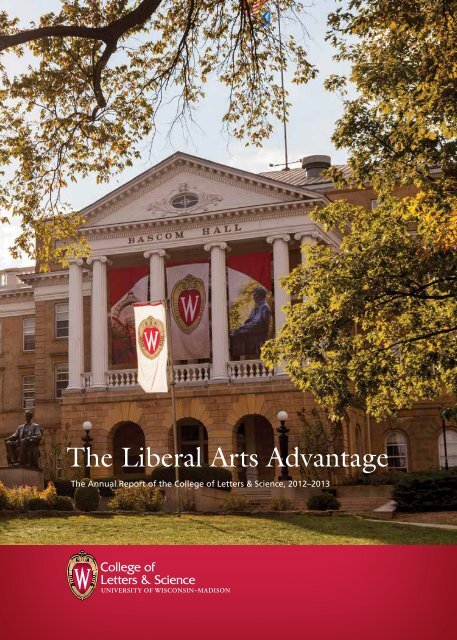
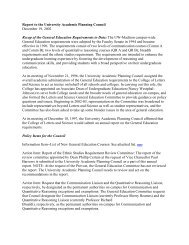
![Research Participant Information & Consent Form - Adults [pdf]](https://img.yumpu.com/50391200/1/190x245/research-participant-information-consent-form-adults-pdf.jpg?quality=85)
